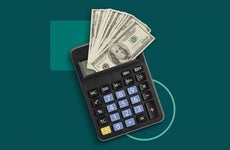How do boat loans work, and are they the best way to finance a boat?

The Bankrate promise
At Bankrate we strive to help you make smarter financial decisions. While we adhere to strict , this post may contain references to products from our partners. Here's an explanation for .
Key takeaways
- Boat loans are a type of personal installment loan that is used exclusively for marine craft-related expenses.
- Online lenders, banks, credit unions and marine lenders offer boat loans, but some impose restrictions on the type of boat you can finance.
- Not all lenders offer boat loans, but some may allow you to use a personal loan for boating-related expenses.
- To qualify for a boat loan you'll most likely need an excellent credit score, stable income and low debt-to-income ratio.
A boat loan is a type of installment loan (typically a personal loan) used to purchase a boat or another marine craft. Like auto loans and traditional personal loans, these installment loans usually come with fixed interest rates, monthly payments and a set repayment term.
Boats can be expensive. Costs for a new boat average $15,000 to $75,000, and luxury vessels may cost millions. Financial institutions, from banks to online lenders and even marine-specific dealerships, offer loans to spread that cost out over a term you can afford.
What are boat loans?
Boat loans are installment loans used for purchasing boats or other marine craft. This means that your funds are sent in a lump sum and are repaid in predetermined monthly payments. The average boat loan term can range between two to 15 years but some lenders extend repayment up to 20 years for larger loans.
Dealerships usually offer secured boat loans that require you to back the loan with collateral. Most non-dealership lenders offer unsecured personal loans that don’t require collateral but are harder to get approved for.
How do boat loans work?
Boat loan details and usage restrictions will vary by lender. Unlike traditional lending products, boat loans come in both secured and unsecured forms. What’s available varies based on your financial health and lender offerings.
Loan amount
Boat loans can range from amounts as small as $1,000 and as large as $100,000. Like other types of loans, the amount you’re approved for will depend on your creditworthiness and the maximum loan amounts offered by the lender.
Repayment terms
Most lenders offer boat loans with repayment terms ranging to 15 years, with some institutions offering repayment terms up to 20 years. Unsecured boat loan terms are often shorter, maxing out around seven years.
Down payment
Not every lender requires a down payment. If the lender does require it, you can expect to make a down payment between 10 percent and 20 percent of the boat’s purchasing price.
Interest rate
Boat loan interest rates follow personal loan rates in that the best rates go to the most creditworthy borrowers. Most lenders have an annual percentage rate (APR) ranging between 8 percent and 35.99 percent.
As of May 2024, the average personal loan rate is 12.20 percent. Any rate that falls below this average is considered a good rate.
Types of boat loans
Lenders that offer boat financing generally offer both secured and unsecured loans. Secured loans, while more risky for the borrower, often have better terms than unsecured loans. However, both come with advantages and potential drawbacks that could impact your financial health for years.
To help set yourself up for financial success, conduct a financial audit to determine which loan type is most reasonable for your current budget and long-term goals.
Secured boat loans
Secured loans are best for borrowers with fair-to-good credit who are certain they can make the monthly payments until the balance is paid off entirely.
Secured boat loans use the boat being purchased as collateral. Terms may be as long as 20 years, giving you a much lower monthly payment than you would have with an unsecured loan. Most unsecured loans terms up to seven years. You may also have a better chance of getting approved for a secured loan if you have lower credit since the lender can repossess the boat if you default.
With such a long term, you will pay more in interest over time.
We only recommend secured loans if you have enough steady income to make the monthly payments easily. Also, if you want to finance an older used vessel, you may struggle to find lenders. Most have year and model requirements.
Other risks of secured loans include nontraditional payment or rate structures. For example, some come with variable rates, which fluctuate based on market conditions. You might also see balloon payments. In exchange for lower monthly payments, you make one large lump-sum payment at the end of the loan.
Types of secured boat loans
- Secured personal loans: Some lenders offer generic secured personal loans. Unlike with marine craft-specific loans, most lenders require that customers open a checking account. The amount in this account acts as collateral, Some banks allow users to borrow up to the amount in the account. Others, like Fifth Third Bank, offer secured loan amounts as high as $500,000. Just ensure the lender allows its funds to be used on boating-related expenses.
- Secured marine loans: Marine dealerships may also provide in-house or third-party loans that are already approved for boating-related purchases. These loans may also come with unique perks like extended service plans and insurance coverage. Just know exactly what you want and can afford before inquiring for a loan. If you’re familiar with the ins and outs of boat loans, it’ll be harder to fall for high-pressure sales pitches.
- Home equity loan:Home equity loans secure the loan with the equity you’ve built up in your home. Most lenders allow you to borrow up to 80 or 90 percent of your home’s equity, which may seem like a good option for those who have paid off their mortgage. However, like other forms of secured debt, you risk your home or property if you default on the loan or fail to make the payments on-time and in full.
Unsecured boat loans
Borrowers in excellent credit health will benefit most from an unsecured boat loan. Those who want to purchase an older model may also need to opt for this type of boat loan.
Unsecured loans are common and ideal for financing older, used models, as they often have lower amounts and shorter terms. However, they often have large minimum and maximum rate ranges. It’s a good idea to prequalify for multiple lenders before officially applying.
While unsecured can be used for just about any purpose, it’s still encouraged that borrowers make sure they can use the funds for boating-related expenses.
Pros and cons of boat loans
How does boat financing work into your budget? Boats are big, long-term expenses. To make sure you’re walking away with the best option for your needs, consider both the pros and cons before laying down any money.

Pros
- Breaks up the payment into smaller, more manageable installments.
- Depending on the lender, the funds may be used for boating-related expenses as well.
- Rates are low for those with a good credit score.
- Payments can be low with a long term.

Cons
- May be hard to get approved for.
- If the loan is secured and you stop making monthly payments, you risk losing your collateral.
- High interest rates could lead to paying off more than you originally borrowed.
- Stretching out a loan term means paying more interest over the life of the loan.
The bottom line
Taking out a boat loan is a long-term commitment that can come with risks if the monthly payments aren’t met. To ensure you’re getting a competitive rate, prequalify for multiple loans and compare boat loan offers.
Related Articles



Weigh all your options: How to choose the best boat loan lender

Boat loans for older boats vs. new boats: What you need to know